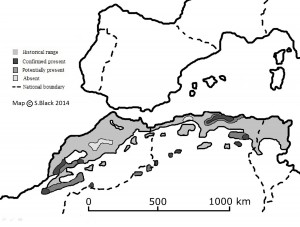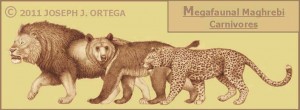
The last pockets of habitat where lions were seen in the mid 20th century (1930s – 40s). Well-known populations in central Morocco (Ifrane) and western Algeria (Oran) had already disappeared.
Although there is no definitve survey data for barbary lion presence in North Africa, it is possible to use the information from reported sightings to map the final decline of the species. A quick summary is given in the figure opposite. The mid-grey expanse is the Maghreb ecosystem which was suitable habitat for lions stretching from south-west Morocco through to north-east Tunisia.
The lightest grey patches in central Morocco and north central Algeria indicate where lions had been present up to the 1920s. The darker grey regions indicate where the last micro-populations survived from the 1930s up to the early 1960s (at the latest). The important last populations may well have been completely isolated in North Setif, Biskra and Batna, the Saharan Atlas, southern Morocco on the Saharan fringe, and the southern High Atlas. It is possible that lions traversed the arid zones between the High Atlas, the Saharan fringe and the Saharan Atlas mountains, but the rest of the Algerian populations in the east were probably quite separate after the early 1900s.
Further Reading:
Black SA, Fellous A, Yamaguchi N, Roberts DL (2013) Examining the Extinction of the Barbary Lion and Its Implications for Felid Conservation. PLoS ONE 8(4): e60174. doi:10.1371/journal.pone.0060174

